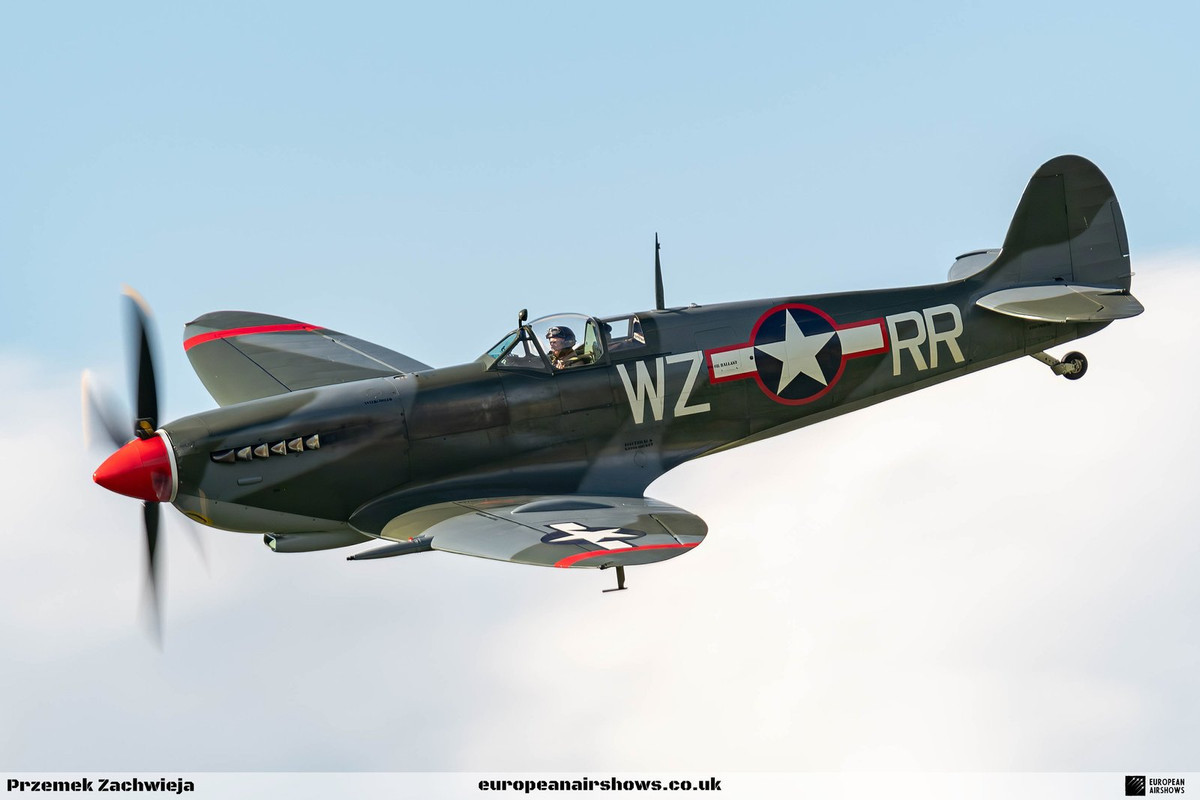
Supermarine Spitfire LF.XVI G-PBIX
About the Spitfire
The Supermarine Spitfire first took to the air in the mid‑1930s and quickly became an icon of British aviation. Designed by Reginald Mitchell for the Royal Air Force, its distinctive elliptical wing and innovative stressed‑skin construction enabled exceptional speed and maneuverability. From early prototypes to successive “marks” that introduced improved armament, stronger structures, and more powerful Rolls‑Royce Merlin engines (and later Griffon engines), the Spitfire was continuously refined to meet the changing demands of aerial combat during World War II. Its elegant design and high performance made it a symbol of determination and hope during Britain’s darkest hours.
Throughout its operational history, the Spitfire evolved from a sleek, single‑seat interceptor into a multifaceted workhorse. Early versions faced significant production challenges with rapid modifications—ranging from upgrades in cockpit design to re‑armament changes driven by combat experience. The aircraft played a decisive role in the Battle of Britain and later proved adaptable as a fighter‑bomber, a high‑altitude interceptor, and even as a carrier‑based fighter (in the Seafire variant). By the end of the war, more than 20,000 Spitfires of various marks had been built, a testament to its versatility and the industry-wide efforts that supported its production.
Even as World War II drew to a close, the Spitfire’s development continued with further modifications to improve high‑altitude performance, extend range with increased fuel capacity, and enhance pilot visibility. The transition from Merlin to Griffon engines ushered in a new era of performance that allowed the aircraft to remain competitive against evolving enemy designs. Long celebrated after the war as a masterpiece of aeronautical engineering, the Spitfire is now an enduring symbol of British ingenuity, frequently appearing in museums and airshows, where it continues to captivate aviation enthusiasts around the world.
Specifications
Crew
1
Length
31 ft 6 in (9.47 m)
Wingspan
37 ft (11.23 m)
Height
13 ft 9 in (4.25 m)
Max Speed
403 mph (650 km/h, 350 kn)
Range
429 mi (692 km, 373 nmi)
Service Ceiling
42,500 ft (12,954 m)
Rate of climb
4,745 ft/min (24 m/s)
LF.XVI Variant
The Mk. XVI LF Spitfire was a low‐altitude fighter variant of the famous Supermarine Spitfire family that emerged late in World War II. Distinguished by its powerful, license‐built Rolls–Royce Merlin 266 engine (the Merlin 66 produced in the United States by the Packard Motor Company, with the “2” prefix added to avoid confusion with its British counterpart), the Mk. XVI was developed essentially on the proven airframe of the earlier Mk. IX but optimized for operations at lower altitudes.
In order to maximize performance where rapid acceleration and tight manoeuvring were required, virtually all Mk. XVI aircraft were fitted with clipped wings. This modification not only reduced drag at low altitude but also enhanced roll rate and overall agility. In addition, many examples featured a cut‐down rear fuselage paired with a bubble canopy that improved pilot visibility during close combat engagements. Rear fuselage fuel tanks with a combined capacity of approximately 75 imperial gallons were standard, reflecting the variant’s design emphasis on the short-range, high-intensity fighter role rather than long-range patrol.
Armament on the Mk. XVI was typically a mix of heavy firepower and precision: two 20 mm Hispano Mark II cannons (each loaded with around 120 rounds per gun) formed the core of its offensive capability, supplemented by two .50‑calibre Browning machine guns (each with 250 rounds per gun). The variant could also be configured to carry small bombs—a 500‑lb bomb on a centerline rack and optionally additional 250‑lb bombs under the wings—for use in fighter-bomber roles.
Produced at the Castle Bromwich factory, a total of approximately 1,054 Mk. XVI units were manufactured. Their performance at low altitude was exceptional; the combination of the Packard Merlin engine and aerodynamic refinements allowed this variant to exhibit superb acceleration and turning ability during combat—qualities that were crucial when countering fast, low-flying enemy aircraft.
Did You Know?
- The destruction of Supermarine’s Itchen and Woolston factories by enemy bombing led to production being shifted to numerous “shadow factories”—with Castle Bromwich becoming the main hub for Spitfire manufacturing.
- Early Spitfires were famous for their elegant, elliptical wing design, chosen not only for its low induced drag but also for its aesthetic appeal—a design feature that helped to capture the public’s imagination.
- The Spitfire Mk IX was actually developed as a “stopgap” measure in response to the Focke‐Wulf Fw 190 threat and was produced from converted Mk Vc airframes before later high‐altitude models appeared.
- Some Spitfire variants were adapted for photo reconnaissance. For example, the PR Mk XIX became the definitive reconnaissance version with increased fuel capacity and specialized camera installations.
- Engine changes sometimes required more than simply swapping powerplants—the installation of the Griffon engine, for instance, necessitated modifications to the cowling, tail, and undercarriage to cope with its different thrust line and increased weight.
Test Your Knowledge
1. Which factory became the main production site for Spitfires after the original Itchen and Woolston plants were destroyed?
Spitfire LF.XVI G-PBIX
Spitfire RW382 is one of the more storied examples of British aviation heritage, with a history that spans military service, static display, film work, restoration, and even a tragic accident before being reborn in a new guise.
Manufactured as a “low-back” Mk XVI at the Castle Bromwich Aeroplane Factory near Birmingham, UK, RW382 was a variant essentially identical to the Mk.IX Spitfire save for its American‐built Packard Merlin 266 engine replacing the standard Rolls-Royce Merlin 66 found on the Mk.IX. Although completed too late to see action in the Second World War, the aircraft was delivered to No. 6 Maintenance Unit at Brize Norton on 20 July 1945.
After the war, RW382 served with a variety of RAF units. In April 1947 she was assigned to No. 604 RAF Auxiliary Squadron at Hendon, remaining in service there until her transfer in April 1950 to No. 33 Maintenance Unit at Lyneham. Later in 1950, RW382 was allocated to the No. 3 Civilian Anti-Aircraft Cooperation Unit at Exeter before being reassigned on 17 October 1950 to the Control and Reporting School at Middle Wallop. Her RAF career was put on hold again in July 1953 when the aircraft was flown first to No. 45 MU at Kinloss and then to No. 29 MU at High Ercall, until she was officially struck off charge on 14 December 1954.
Following her military flying days, RW382 found a second life as a static instructional airframe. She was allocated to No. 609 Squadron at Church Fenton as instructional airframe 7245M (at times seen painted as M7245) before being transferred on 28 November 1955 to serve as a gate guardian at Leconfield, sporting the designation RW729. In 1968 the Spitfire was removed from her pole for use in the film “Battle of Britain” where she appeared in static scenes – cleverly disguised as an earlier, high-back model – and was later returned to a display position at RAF Uxbridge.
The aircraft’s journey continued with a refurbishment at No. 5 Maintenance Unit, Kemble beginning on 19 May 1970. She reappeared on 6 July that year at Leconfield in a distinctive green/dark earth camouflage scheme adorned with 1940-style roundels—a livery she retained when transferred by road on 4 April 1973 to RAF Uxbridge, where she remained mounted on a display pole adjacent to the main gate until 1988.
In 1988, Tim Routsis of Historic Flying Ltd acquired RW382, and shortly thereafter in 1989 the project aircraft was sold to American David Tallichet. A two-year restoration effort by Historic Flying Ltd at Audley End culminated in RW382’s first post-restoration test flight on 3 July 1991, when she was registered as G-XVIA. The aircraft later changed hands again when Bernie Jackson of Manitoba, Canada purchased her in 1994. The following year she was shipped to the United States and re-registered on the US civil register as N382RW.
RW382’s turbulent career took a tragic turn in June 1998. While flying from Chico, California—after a successful appearance at the Carson Valley Airshow—back to her base at Minden-Tahoe, Nevada, the aircraft was piloted by 37-year-old ex-RCAF pilot Thomas Jackson, nephew of owner Bernie Jackson. Despite obtaining a preflight weather briefing for a visual flight (VFR) and predicting a 30‐minute trip at 1500 feet above ground level, inclement weather with obscured mountainous terrain proved fatal. Witnesses reported that the aircraft, while attempting to turn back up the valley, struck the wall of Blue River Canyon. After the Civil Air Patrol picked up a distress beacon signal on 4 June, a California Highway Patrol helicopter recovered the wreckage later that afternoon. The remains were shipped back to the UK and registered as G-PBIX to Pemberton-Billing LLP.
Restoration efforts began anew in 2011 when Peter Monk’s Spitfire Company Ltd took charge of the battered airframe at Biggin Hill. In a comprehensive project, RW382 was converted from her original low-back Mk XVIe configuration to a high-back Mk IX layout, now equipped with a Rolls-Royce Merlin engine, complete full wingtips, and an earlier rounded tail design. The first post-restoration test flight was carried out on 18 September 2013 by Clive Denney, who had himself been involved in the earlier Audley End restoration. At that time her new livery featured the markings of RAF No. 322 (Dutch) Squadron, with the code “3W-P.”
In September 2020 the aircraft underwent another striking transformation. Now in the personal ownership of Peter Monk, RW382 was repainted in the markings of the Mk.IXc “Porky II,” an aircraft formerly assigned to the USAAF 309th Fighter Squadron, 31st Fighter Group in the Mediterranean Theatre in 1943. This scheme pays homage not only to the ties between American forces and East Anglia during World War II but also commemorates Lt. Robert Connor, the pilot of “Porky II.” The aircraft proudly sports nose art depicting Porky Pig—a playful nod to the squadron’s nickname “Porky.” Originally, the 309th Fighter Squadron had transitioned from P-39s to Spitfire Vs on arrival in Britain in 1942, later operating Spitfire Mk IXs to provide cover, before eventually converting to the longer-ranged P-51 Mustangs in March 1944.










